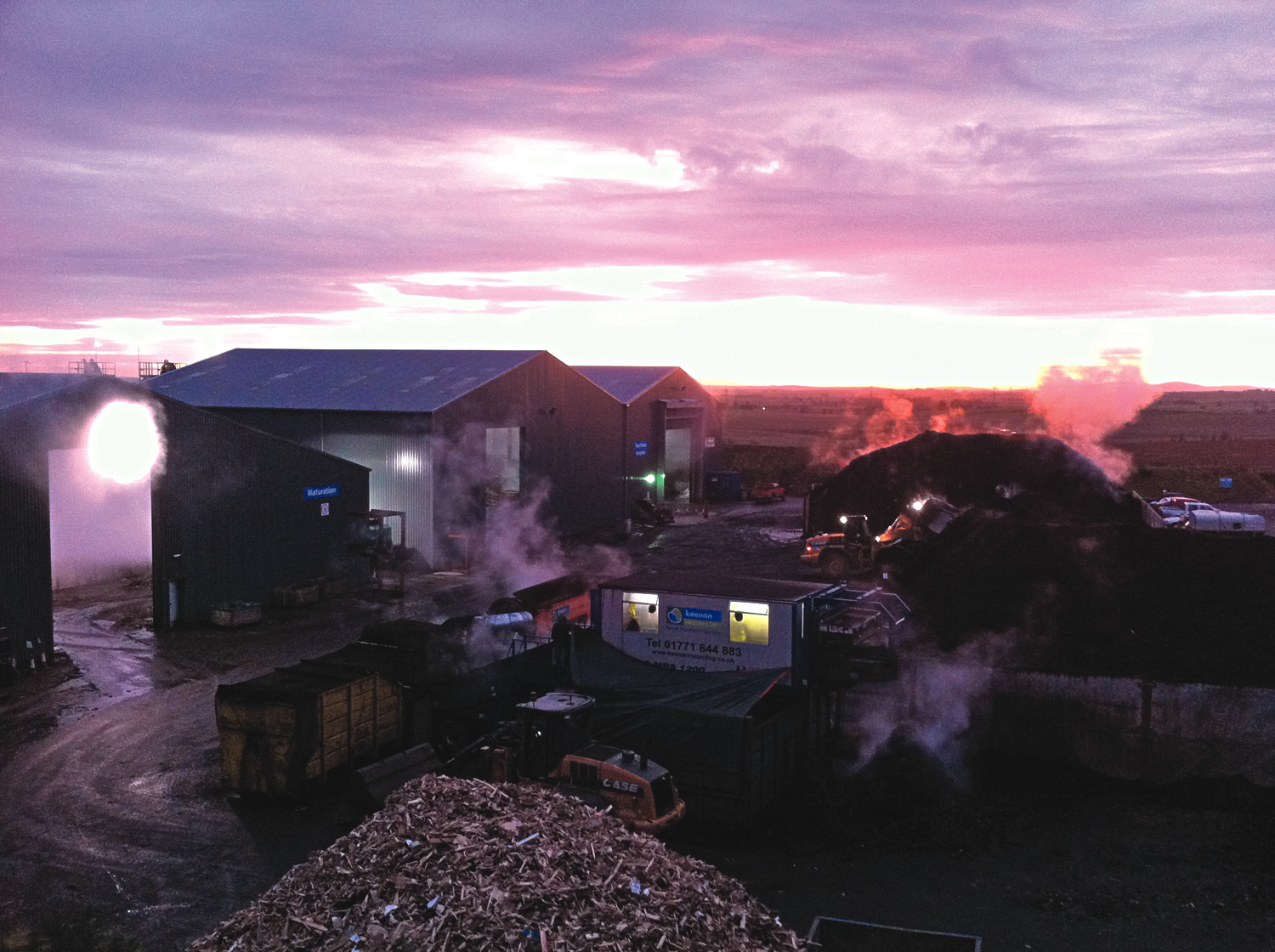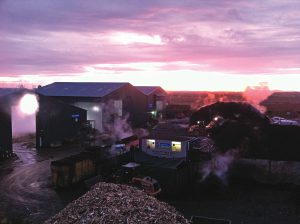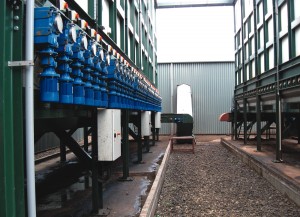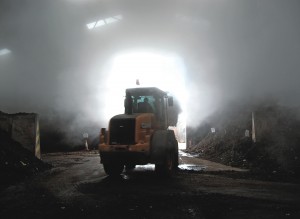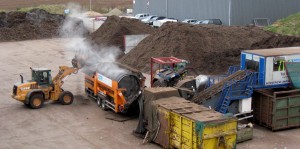Evolving from shredded bark chips to vertical in-vessel composting for household and commercial food waste, Keenan Recycling Ltd. has helped define the organics recycling industry in Scotland. Part I
David Riggle
BioCycle April 2012, Vol. 53, No. 4, p. 21
That part of the business took off surprisingly well and eventually he bought a second-hand Doppstadt trommel in order to market more than one size of mulch. Shredders and trommels are expensive machines to sit idle, and Keenan was always looking for extra work to keep them busy. That eventually led him to an opportunity that would shape his operation for a wider benefit than just his own business.
Households in Aberdeenshire would bring their garden waste to Household Recycling Centres (then generally called ‘Civic Amenity Sites’). Much of the material was landfilled but Keenan thought he might be able to run the material through the hammermill, compost it in windrows and make something useful. He did just that and has since grown the company, Keenan Recycling, Ltd., to eventually include commercial food waste collection and installation of an in-vessel composting system.
Landfill Directive Sets The Stage
All European Union Member States — including the United Kingdom — were required to implement the European Commission’s 1999 Landfill Directive by July 16, 2001.The main aim of the Landfill Directive is to reduce the amount of biodegradable waste going to landfill. Legally binding compliance deadlines were established for gradually increased percentages of organics diverted. In the UK, using a 1995 baseline, biodegradable municipal wastes going to landfill were to be cut to 75 percent of 1995 levels by 2010, 50 percent by 2013 and 35 percent by 2020.
The effect of that implementation process across Scotland, England, Northern Ireland and Wales was profound. In the UK, elected Local Authorities governing rural counties, cities and the like, are responsible for household waste collection, whether they run the service themselves or contract it out. Prior to 2001, typically less than 10 percent of the entire household waste stream was either recycled or composted with only 2 to 3 percent of that being composted. Consequently, as 2001’s implementation deadline came into view, Local Authorities suddenly began looking for disposal alternatives for garden waste. At the same time, Keenan’s Recycling Ltd. had been established and Keenan was set up to do windrow composting with a small tractor-pulled turner. He soon realized the company could start charging a gate fee to take the green waste from the Local Authorities and help boost their overall recycling rates. This worked well enough that he was able to sell the solid fuel part of the business and focus on composting full time.
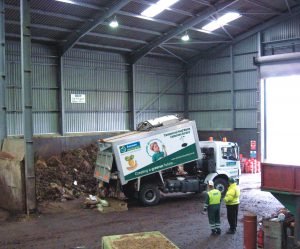
In 2010, Keenan Recycling rolled out food waste collection service to commercial businesses. It uses a toploading truck, shown above tipping in the reception hall.
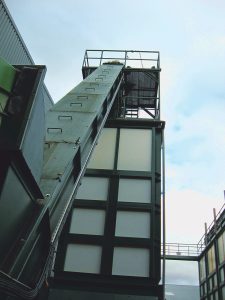 To comply with the UK’s regulations for composting animal by-products, a vertical in-vessel system was installed. After blending ground yard trimmings and food waste, material is conveyed to the top of the vessel.
To comply with the UK’s regulations for composting animal by-products, a vertical in-vessel system was installed. After blending ground yard trimmings and food waste, material is conveyed to the top of the vessel.Growing Realizations
Around the same time, Gregor Keenan, joined the company as Finance and Technical Director at his brother’s invitation. “Grant called to say he thought this composting thing was really going to take off and asked if I would I like to join him,” says Gregor. “I’d been working in London and wondering how I could get back up to Aberdeenshire. It was a perfect opportunity. The plan was for Grant to get in a suit and go out and drive the business forward while I would stay on site and keep an eye on the technical and financial side of the operation.” Simply put, the plan worked.
Aberdeenshire Council planners also noticed the growth of the company that was now composting 3,000 to 4,000 tpy of garden waste from two Local Authorities. They decided to require full planning approval and a waste management license from the Scottish Environment Protection Agency, both of which Keenan Recycling Ltd. obtained in 2004. The company also applied for funding to help grow their business. It received grants from Aberdeenshire Council in 2004-2005, as well as $95,000 (at today’s rates) from the national Waste Resources Action Programme (WRAP) in 2005. “Government drivers were pushing in our direction,” says Gregor. “With the WRAP funding we were able to install a concrete pad, and an office and workshop, and procured a big loading shovel that handles 3 to 4 metric tons in one scoop. That made a big difference to the efficiency of the operations.” In 2005, Moray Council, another Local Authority of around 35,000 households bordering Aberdeenshire on the west, also decided to initiate curbside collection of garden waste and put a tender out for composting it. Keenan Recycling bid and won a 5-year contract.
Shaped By Foot-And-Mouth
In February 2001 — while the Landfill Directive was being implemented and the National Waste Plan discussed — a UK farmer discovered the first case of Foot-and-Mouth-Disease seen in the country in 34 years. This highly infectious viral disease of cloven-hoofed animals spread rapidly and required 10 million sheep and cattle to be killed before it was brought under control 10 months later. According to government sources, the epidemic was probably caused by pigs that had been fed infected meat in restaurant food waste that had not been properly heat-sterilized. It is estimated to have cost the UK over $12.7 billion in losses in the agriculture and support industries and the tourist sector.
This outbreak was — and still is — of great importance to composters and organics recyclers due to the regulatory changes and process requirements it brought to the industry. Given that the cause was determined to be infected meat, steps were taken to improve handling of all animal by-products. These materials were classified by their risk as Category 1, 2 or 3. Category 3, low risk materials, mainly consisted of food waste from households and restaurants (called catering waste in the regulations), material “that had once been food,” and some abattoir wastes like blood and feathers.
The 2005 Animal By-Products Regulations (ABPR) clearly stipulated that Category 1 animal by-products (e.g., diseased animals) could not be composted at all. However, if one chose to compost Category 2 (after pretreatment such as heat sterilization) or Category 3 by-products, it could not be legally done in open windrows. Only an in-vessel system or enclosed windrows could be used, and there were very strict treatment standards to follow. In a closed reactor unit, these are: Maximum particle size of 5.7 inches, minimum temperature of 60°C, and minimum time at that temperature of 2 days; or Maximum particle size of 2.3 inches, minimum temperature of 70°C, and minimum time at that temperature of 1 hour.
In a housed windrow — turned windrows in a building, ideally with a concrete floor — the maximum particle size is 15.7 inches, and a minimum temperature of 60°C must be achieved for 8 days “during which the windrow shall be turned at least 3 times at not less than 2 day intervals” and must have achieved 60°C for at least 2 days prior to each turn, and also following the third turn.”
The implications of these developments were not lost on the Keenan family. “Foot-and-Mouth was certainly a driver for in-vessel composting facilities like ours,” says Gregor. “The regulations definitely required a more technical approach.” As they’d become more proficient with windrow composting, Grant had been looking at other systems that would allow the company to do more. He investigated drums, covered aerated bays and other types of in-vessel systems before deciding on a vertical composter — specifically a 12-chamber VCU™ system, originally developed in Australia and New Zealand in the 1990s. “It was robust, had the capacity to handle 30,000 tpy in a small footprint, and the ‘dirty’ (input)’’ and ‘clean’ (output) areas were clearly demarked, as the regulations require,” Gregor notes.
The Keenans looked for funding to get this system in place and, again, support from government bodies helped bring this project more quickly to fruition. First, Aberdeen City Council and SITA, its waste contractor, decided to add household food waste in compostable “biobags” to the garden waste bins already being collected, rather than do a separate collection of food waste. Discussions about how best to handle this new commingled, ABPR-regulated waste stream helped inform Keenan’s choice of the VCU Technology, as did the knowledge that they would have a guaranteed feedstock for the foreseeable future as a subcontractor to SITA. Additionally, an application to WRAP for a facility that could handle Category 3 food waste — a practice that WRAP wanted to encourage — paid off again with a grant of $683,000.
Because they would be handling catering waste, a Pollution Prevention and Control (PPC) permit was required from the Scottish Environment Protection Agency (SEPA), as was approval from the State Veterinary Service under the APBR regulations. All this took time, but finally, with additional investment from their father, Mel Keenan, construction of the $2 million VCU system and a negatively aerated maturation shed with 8 bays and a biofilter began in 2007 and was commissioned in November 2008. A compost operator, Graham Duguid, was hired to optimize performance of the new composter. The facility was ready for the Aberdeen City commingled food/garden waste collection, which rolled out over 2009.
Zero Waste Future
As the company became proficient in dealing with food waste from local authority household collections in the in-vessel system, along with some food processing wastes, interest from other commercial enterprises began to grow. Early in 2010, Keenan Recycling purchased a Tuberg 8-metric ton toploader collection vehicle and promoted its services to businesses in and around Aberdeen — the first service of its kind in northeast Scotland. For a fee, customers are supplied with both internal and external bins along with the first 3 months supply of compostable liners. “Not only do our customers see an increase in recycling rates,” notes Gregor, “but also a reduction in the frequency of residual waste lifts — which will bear the cost of the landfill tax which is increasing to $101/metric ton on April 1, 2012. That is just the tax, and doesn’t include the cost of disposal, which can take the total over $160/metric ton.”
In June 2010, the Scottish Government launched Scotland’s Zero Waste Plan. It indicates that by 2013 separate food waste collections will be mandatory and food waste could be banned from the landfill in Scotland by 2015.This plan goes beyond the Landfill Directive requirements (only 35% of 1995 levels of biodegradable municipal waste going to landfill by 2020). Scotland was landfilling around 1.76 million metric tons/year in 1995, which means it can only landfill 620,000 tons in 2020. But the Scottish Government’s Zero Waste Plan has set its own, more aggressive targets, e.g., only 5 percent to landfill (of all wastes) in 2025.
No wonder then that, on July 29, 2010, Alex Salmond, Scotland’s First Minister, publicly launched Keenan’s commercial recycling collection service at the Shell Upstream Europe offices in Aberdeen. Shell was one of the first 50 companies to sign up for the collection. “Keenan Recycling’s exciting new service is a significant move in the right direction,” said Salmond. “It produces a valuable resource from food waste, reduces the amount of waste being sent to landfill and cuts down greenhouse gas emissions.”
To provide additional capacity for this rapidly growing service (over 150 customers as of March 2012), Zero Waste Scotland (WRAP’s Scottish identity) provided another $221,436 to help fund Keenan’s expansion. The funds were used to purchase a second Tuberg 8-metric ton food waste collection vehicle and two lifters, and another trommel. The $2 million expansion added 6 more in-vessel units in May 2011 to the 12 units already operating, raising in-vessel processing capacity by 15,000 tpy to 45,000 tpy. Adding another 45,000 tpy of garden waste, the site’s current capacity sits at around 90,000 tpy.
Although these developments have moved the company a good distance from the days of a second-hand shredder and trommel processing a few hundred tons of garden waste, it still feels like the Keenan Recycling Ltd has not yet reached its limits. In 2010, the company was awarded both ISO 9001 and ISO 14001 accreditations (for quality management and sustainable environmental management standards, respectively). “As a small company, our ambition is to grow,” says Gregor, noting that they are looking to expand into other geographic areas, including Inverness and Dundee in 2012 and 2013. “Since launching the business we have continually strived towards approaching the waste issue through innovative ideas to ensure that we are industry leaders in organics recycling,” concludes Grant Keenan. “The recent expansion places us in a key position for additional growth in the future.”
David Riggle is a former Managing Editor/International Editor of BioCycle and has been living and working in Scotland for the past 14 years. He has been employed by the Waste Services department at Stirling Council since 2001, and before that coordinated development of a Local Agenda 21 Plan with community and environmental organizations in Fife.
Part II of this article, to appear in May 2012 BioCycle, discusses the compost markets side of Keenan’s Recycling, including compliance with the UK’s PAS 100 standards. Insights into operating the facility’s in-vessel composting system are provided as well.
References
DEFRA animal by-products rule: http://archive.defra.gov.uk/foodfarm/byproducts/documents/compost_guidance.pdf.
National Waste Plan for Scotland between 1999 and 2003. [see http://www.scotland.gov.uk/Resource/Doc/47133/0009763.pdf.


